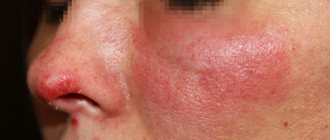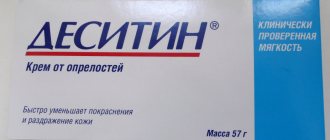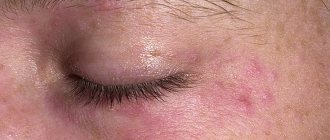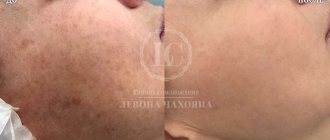Is it possible to eliminate pigmentation with cosmetics, is it dangerous to treat spots with laser radiation, is it possible to completely remove a pigment spot and will it appear again? A dermatocosmetologist answers these and other questions.
Anastasia Tselishcheva
, cosmetologist, dermatologist, laser therapist at the Lazerjazz Khamovniki clinic, expert in the field of hardware cosmetology https://www.llc1.ru
The main reason for the appearance of pigmentation at any age is ultraviolet radiation, which damages the skin. With age, photodamage to the skin increases, internal factors affecting melanogenesis, plus illiterate skin care during the period of insolation are superimposed - all this ultimately leads to the appearance of pathological pigment spots.
Ultraviolet rays of type A and B can have a negative effect on the skin. The former are able to penetrate into the deep layer of the skin (dermis) and damage the DNA of cells, and with prolonged exposure, collagen and elastin fibers, which leads to thinning and decreased elasticity of the skin. Ultraviolet B rays penetrate only the surface layer of the skin (epidermis) and activate the production of melanin. This contributes to the appearance of tanning, rough skin and age spots.
Of course, not only ultraviolet radiation can cause pigmentation. Hormonal imbalance, stress, nutrient deficiency (iron, copper, zinc, B vitamins, vitamin C), inflammatory processes in the skin and improper use of cosmetics also play an important role in the formation of age spots.
Pigmentation varies
The depth of the pigment in the skin depends on the causes of pigmentation and its type. In this regard, the lifetime of the pigment can indirectly indicate its depth. If the pigment has been there for several years, then we can assume that it is deep, since the surface pigment can peel off over time during the natural renewal of the top layer of skin. For example, the localization of post-inflammatory pigmentation is determined by the depth of the previous inflammatory process. It should be noted that deep-lying age spots are more difficult to remove.
Clinical manifestations
Various dermatological diseases and conditions with possible outcomes in hyper- or hypopigmentation are presented in table. 1 .
Table 1. Possible outcomes of dermatological diseases and skin conditions
| Disease/Condition | Hyperpigmentation | Hypopigmentation |
| Infections | ||
| Impetigo | + | + |
| Syphilis | – | + |
| Leprosy | – | + |
| Herpes simplex | + | + |
| Chicken pox | + | + |
| Allergic or immunological conditions | ||
| Insect bites | + | + |
| Atopic dermatitis | + | + |
| lupus erythematosus | + | + |
| Sarcoidosis | + | + |
| Photodermatitis | + | – |
| Scleroderma | + | + |
| Papulosquamous dermatoses | ||
| Lichen planus | + | – |
| Tinea striata | – | + |
| Psoriasis | + | + |
| Drug-induced dermatoses | ||
| Phototoxic dermatitis | + | – |
| Persistent drug erythema | + | – |
| Stevens-Johnson syndrome | + | + |
| Intralesional corticosteroid injections | – | + |
| Topical corticosteroids | – | + |
| Hydroquinone | + | + |
| Physical effects | ||
| Minor injuries | + | + |
| Burns | + | + |
| Abrasions | + | – |
| Radiotherapy | + | – |
| Dermabrasion | + | + |
| Chemical peeling | + | + |
| Cryotherapy | + | + |
| Other states | ||
| Acne | + | – |
| Mycosis fungoides | + | + |
| Persistent dyschromic erythema | + | – |
In the diagnosis of post-inflammatory dyschromia, one should take into account a history of a previous inflammatory/pathological process, medication use, excess sunlight, frequent visits to a solarium, or skin damage in the affected area ( Fig. 1, 2 ). It is important to find out the hereditary history - the presence of hyper- or hypopigmentation in close relatives.
The distribution of hypermelanotic lesions depends on the location of the original dermatosis or the site of injury. Their color varies from light brown to black - the shade will be lighter if the pigment is located in the epidermis, and darker if it is in the dermis.
Rice. 1. Areas of post-inflammatory hyperpigmentation on the face of a 42-year-old woman after acne (www.medscape.com)
Rice. 2. Multiple foci of post-inflammatory hypopigmentation on the arm (www.bmj.com)
It's a serious matter
Currently, the only effective method for removing pathological pigmentation is the use of lasers and broadband pulsed light (IPL). Laser removal works specifically (the target is the melanin pigment), and IPL affects not only melanin, but also oxyhemoglobin in the vessels, this is its advantage, since most pigment spots underneath have a network of expanded surface vessels that enhance the color of pigmentation and aggravate metabolic processes in the skin.
In second place are professional peelings and injectable preparations with a lightening effect. But all these procedures work in conjunction with properly selected care, otherwise there is a high risk of relapse.
Skin preparation
Treatment for pigmentation should begin about a month before laser and IPL therapy, sometimes earlier.
The main task is to stop stimulating melanin production (exclude sun exposure and use sunscreen) and suppress inflammation, if any. The next step is to prepare the skin using superficial peels to eliminate hyperkeratosis (an excess layer of dead skin cells resulting from exposure to ultraviolet rays) and injections to hydrate and relieve the skin of oxidative stress. Laser and photo radiation have a direct destructive effect on pigment in both the superficial and deep layers of the skin.
In parallel with laser and phototherapy of the skin, it is necessary to adhere to proper care to avoid relapse. First of all, these are sunscreens with a protection factor of 30-50, even in cloudy weather. Also therapeutic serums and creams, the active components of which affect different parts of the pigment formation mechanism (kojic acid, arbutin, niacinamide, ascorbic acid, retinol, fruit acids).
Treatment of post-inflammatory hyperpigmentation
Postinflammatory hyperpigmentation (PIH) is a common complication of inflammatory dermatoses and a potential complication of cosmetic procedures in patients of color. Traditionally, treatment of post-inflammatory hyperpigmentation involves treating the underlying dermatosis (if applicable), recommending sun protection to address potential flare-ups from melanogenesis-inducing UV exposure, and allowing time for hyperpigmentation to resolve spontaneously. Although these methods still constitute a fundamental approach to treatment, in my experience, I can say that patients are often dissatisfied with adherence to this treatment regimen, which does not include active treatment of PIH, which is understandable given that patients often experience cosmetic discomfort caused by pigmentary changes. Thus, topical application of skin lightening agents and cosmetic procedures such as chemical peels are usually required to speed up the resolution of PIH, thereby increasing patient satisfaction with the skin condition. Although this article will discuss several effective treatment options for PIH, none of them provide the quick resolution that patients desire; therefore, matching treatment modalities to patient expectations is an important component of treatment for PIH. The use of corrective cosmetics can be a useful adjunct to camouflage damaged skin for a period of several weeks to several months until PIH resolves.
Agents for topical use
Evidence supporting treatment for PIH is limited to a few published studies and an isolated experiment. The most commonly used drugs in the treatment of PIH are those containing hydroquinone. Hydroquinone reduces hyperpigmentation by inhibiting the enzyme tyrosinase, limiting the rate of melanin synthesis, and is considered the gold standard of skin lightening agents; however, the use of hydroquinone is associated with the risk of creating a halo of hypopigmentation at the periphery of damaged skin, especially when treating small hyperpigmented areas characteristic of PIH caused by acne. Also, the use of hydroquinone may be associated with the appearance of irritant contact dermatitis, especially when treated with hydroquinone at a concentration of more than 4%, with the appearance of exogenous ochronosis associated with prolonged or improper use of hydroquinone.
Despite the widespread use of various treatments for PIH, there is a paucity of published studies examining the effectiveness of hydroquinone for these indications. In a 12-week open-label study of 28 participants (12 of whom had PIH), microsponges containing 4% hydroquinone and 0.15% retinol demonstrated significant improvements in disease severity, pigmentation intensity, and colorimetry scores compared with baseline. condition (P <0.001) [1]. The largest published study on the treatment of PIH is a multicenter randomized trial that compared the effectiveness of a triple combination of bleaching cream containing fluocinolone, acetonide 0.01%, hydroquinone 4% and tretinoin 0.05%, each used for more than 8 weeks (N = 792) . Forty-five percent of participants experienced complete or near-complete lightening of hyperpigmentation areas after 8 weeks of using a triple combination of lightening creams; however, the study did not have enough observations to detect a significant difference between the triple lightening cream combination and all double combinations [2].
We examined the potential of topical retinoids in the treatment of post-inflammatory hyperpigmentation. In a 40-week randomized, double-blind, controlled trial of 54 participants with facial PIH, significant improvement (P < 0.001) was observed after 40 weeks of treatment with tretinoin compared with vehicle cream. A decrease in pigmentation was also observed in colorimetric and histological studies [3]. A published study showed that tazarotene 0.1% cream [4], adapalene gel 0.1% [5], and a fixed combination of clindamycin phosphate 1.2% with tretionin gel 0.025% [6] are effective in the treatment of PIH caused by acne. .
We studied the use of 15% azelaic acid gel in the treatment of PIH caused by acne. A 16-week, open-label, pilot study of 20 participants with moderate-to-severe acne and PIH demonstrated an improvement of at least 2 points in all participants on the Global Research Assessment of PIH Severity; in 31% of participants, PIH disappeared by the 16th week of treatment [7].
Although there is no research into the treatment of PIH alone, cosmetics containing herbal ingredients with lightening properties may be considered as complementary or alternative treatments for post-inflammatory hyperpigmentation. These preparations contain kojic acid, soy, licorice extracts, niacinamide and N-cetyl glucosamine [8]. When used alone, these agents typically demonstrate modest improvement in facial hyperpigmentation that is at best comparable to, but not greater than, 4% hydroquinone. In my experience, cosmetics are especially useful in combination with hydroquinone preparations to enhance the brightening effect or as hydroquinone protectants when long-term treatment is required.
Cosmetic procedures
Chemical peels are often used as an adjunct to topical therapy in the treatment of PIH because they remove excess epidermal melanin and increase the penetration of topical skin lightening agents. The evidence for the use of chemical peels for the treatment of PIH is limited to small studies [9–12], but they appear to be capable of accelerating the resolution of hyperpigmentation when used concomitantly with bleaching agents. In patients of color, peeling should be limited to superficial peeling agents such as 20% to 70% buffered glycolic acid, 20% to 30% salicylic acid, and Jessner's solution to minimize the risk of potential the occurrence of pigment complications that disfigure the skin [13]. In patients with dark skin types, lower concentrations of trichloroacetic acid (10%-20%) may be used with caution because there is only limited data regarding the safety of these peels. To ensure a safe approach to chemical peel treatment, it is necessary to start with the lowest concentration of any peeling agent used and work your way up. This approach is strongly recommended in patients of color, given the high risk of developing iatrogenic depigmentation.
Lasers have long been used to treat PIH with conflicting results. Literature data are limited to small case series and reports [14–16]. In my experience, nonablative fractional skin resurfacing combined with hydroquinone before and after treatment can be recommended for patients with persistent PIH. However, at the same time, a small randomized trial of fractional photothermolysis did not reveal its effectiveness in the treatment of PIH [17]. Further studies are needed to confirm the safety and effectiveness of laser therapy for the treatment of PIH, especially in patients with Fitzpatrick skin phototypes IV to VI.
conclusions
Treatment of post-inflammatory hyperpigmentation remains a major challenge in patients of color. Maximum patient satisfaction and treatment results are achieved by combining treatment of the underlying cause of PIH with the use of skin lightening products, judicious use of cosmetic procedures, and consistent sun protection measures. The compliance of the patients themselves is also important.
Literature
- Grimes P.E. A microsponge formulation of hydroquinone 4% and retinol 0.15% in the treatment of melasma and post-inflammatory hyperpigmentation. Cutis. 2004;74:362-368.
- Taylor S, Grimes P, Lim J, et al. Postinflammatory hyperpigmentation. J Cutan Med Surg. 2009;13:183-191.
- Bulengo-Ransby SM, Griffiths CE, Kimbrough-Green CK, et al. Topical tretinoin (retinoic acid) therapy for hyperpigmented lesions caused by inflammation of the skin in black patients. N Engl J Med. 1993;328:1438-1443.
- Grimes P, Callender V. Tazarotene cream for postinflammatory hyperpigmentation and acne vulgaris in darker skin: a doubleblind, randomized, vehicle-controlled study. Cutis. 2006;77: 45-50.
- Jacyk W.K. Adapalene in the treatment of African patients. J Eur Acad Dermatol Venereol. 2001;15(suppl 3):37-42.
- Callender VD, Young CM, Kindred C, et al. Efficacy and safety of clindamycin phosphate 1.2% and tretinoin 0.025% gel for the treatment of acne and acne-induced post-inflammatory hyperpigmentation in patients with skin color. J Clin Aesthet Dermatol. 2012;5:25-32.
- Kircik L.H. Efficacy and safety of azelaic acid (AzA) gel 15% in the treatment of post-in flammatory hyperpigmentation and acne: a 16-week, baseline-controlled study. J Drugs Dennatol. 2011;10:586-590.
- Leyden JJ, Shergill B, Micali G, et al. Natural options for the management of hyperpigmentation Published online ahead of print May 31, 2011]. J Eur Acad Dermatol Venereol. 2011;25: 1140-1145.
- Bums RL, Prevost-Blank PL, Lawry MA, et al. Glycolic acid peels for post in flammatory hyperpigmentation in black patients, a comparative study. Dermatol Surg. 1997;23:171-174; discussion 175.
- Grimes P.E. The safety and efficacy of salicylic acid chemical peels in dark racial-ethnic groups. Dermatol Surg. 1999;25:18-22.
- Lee HS, Kim IH. Salicylic acid peels for the treatment of acne vulgaris in Asian patients. Dermatol Surg. 2003;29:1196-1199; discussion 1199.
- Garg VK, Sinha S, Sarkar R. Glycolic acid peels versus salicylic-mandelic acid peels in active acne vulgaris and post-acne scarring and hyperpigmentation: a comparative study [published online ahead of print December 8, 2008]. Dermatol Surg. 2009; 35:59-65.
- Rossi A, Alexis AE Cosmetic procedures in skin of color. G Itale Dermatol Venereol. 2011;146:265-272.
- Kim S, Cho KH. Treatment of procedure-related postinflammatory hyperpigmentation using 1064-nm Q-switched Nd:YAG laser with low fluence in Asian patients: report of five cases. J Cosmet Dermatol. 2010;9:302-306.
- Kim S, Cho KH. Treatment of facial postin flammatory hyperpigmentation with facial acne in Asian patients using a Q-switched neodymium-doped yttrium aluminum garnet laser Ipublished online ahead of print July 9, 2010]. Dermatol Surg. 2010;36: 1374-1380.
- Rokhsar CK, Ciocon DH. Fractional photothermolysis for the treatment of post in flammatory hyperpigmentation after carbon dioxide laser resurfacing Ipublished online ahead of print February 22, 20091. Dermatol Surg. 2009;35:535-537.
- Kroon MW, Wind BS, Meesters AA, et al. Non-ablative 1550 nm fractional laser therapy not effective for erythema dyschromicum perstans and postinflammatory hyperpigmentation: a pilot study Ipublished online ahead of print July 14,2011]. J Dermatolog Treat. 2012;23:339-344.
Anti-pigmentation cream
Provided that the pigmentation is superficial and competent care is prescribed, which hits every link in the formation of pigmentation, it can be dealt with with cosmetics. But most often, properly selected care is, although important, still part of the treatment and, as an independent unit, is only a prevention of the strengthening of existing pigmentation and the formation of new pigment spots.
Table of contents
- Etiology and pathogenesis
- Clinical manifestations
- Principles of treatment and hardware correction
Post-inflammatory dyschromia (post-inflammatory hyperpigmentation, post-inflammatory hypopigmentation) are acquired pigmentation disorders that arise due to the tendency of melanocytes to excessive or insufficient pigment synthesis, as well as due to the accumulation of pathological pigment in the skin (for example, lipofuscin during aging).
In our company you can purchase the following equipment for the treatment of post-inflammatory dyschromia:
- M22 (Lumenis)
- Fraxel (Solta Medical)
Post-inflammatory hyperpigmentation is one of the most common dermatological conditions that develops more often on dark skin. One study found that acne pigmentation occurs in 65.3% of African Americans, 52.7% of Hispanics, and 47.4% of Asians. It can occur at any age and affects both women and men equally.
As for hypopigmentation , in one study involving 423 healthy people, 20 (4.7%) had at least one area of skin lightening. Local discoloration is especially noticeable on dark skin phototypes due to the contrast with surrounding healthy tissue.
Pigment spot and laser
Exposure to laser radiation is safe for pigment spots, but before laser removal of pigmentation, it is necessary to check for benignity by collecting anamnesis and instrumental methods.
When collecting anamnesis, it is important to find out the duration and dynamics of pigmentation, hereditary predisposition, the presence of chronic diseases, medication use, frequency of sun exposure, and cosmetic procedures. Among the instrumental methods used are dermatoscopy, highlighting pigment spots with a Wood's lamp, mexametry, as well as the 3D visualization method using special cameras. All this allows not only to protect the patient from unwanted effects, but also to choose a more effective method of removing pigmentation.
What can modern cosmetology offer?
Photodamage, photoaging, and pigmentation have been shown to be closely related. And this fact should be taken into account when choosing cosmetic procedures - it is necessary not only to remove external manifestations (actually unpleasant areas of darkened skin), but also to act deeper, preventing the initiation of deep destructive aging processes in the dermis.
Treatment algorithm for hyperpigmentation
- After assessing the severity of pigmentation, the cosmetologist can offer several correction options.
- For selected lesions or as protection: combination of topical agents with a high SPF sunscreen.
- For moderate pigmentation: external chemical peeling, non-ablative low-intensity laser.
- For intense pigmentation: fractionated radiofrequency, Q-laser or picosecond laser, non-ablative high-intensity laser, microneedling, IPL system.
Once and for all
It is quite possible to completely get rid of pigmentation, but it is important to understand that this will require time and well-coordinated work between the doctor and the patient. The first task is to recognize the cause of pigmentation and select the most effective method of combating it. The second task is to follow skin care recommendations and fill existing deficiencies.
Replenishing the deficiency of microelements (copper, zinc, iron, ferritin, vitamin D) and correcting hormonal levels (thyroid hormones and sex hormones) is an important point that allows you to increase the regenerative function of the skin and effectively and safely use hardware methods for removing pigmentation.
The standard course of hardware removal of pigmentation is 4-6 procedures at intervals of once a month. But everything is individual and sometimes more procedures are required.
Laser treatment of pigmentation is not recommended for pregnant women, breastfeeding women, and those with severe forms of cardiovascular, endocrine, autoimmune diseases and oncology. Also an absolute but temporary contraindication is tanning less than a month old.










